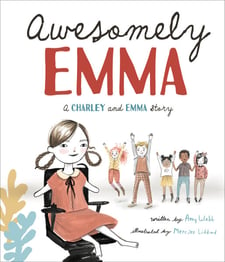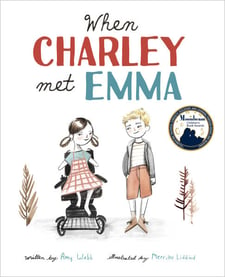Amy Webb is the author of Awesomely Emma, the much-anticipated follow-up to When Charley Met Emma. We chatted with her to learn more about the inspiration and process behind this inclusive and inspiring new picture book.
Hi Amy! Tell us a little about you, your family, and what led you to writing children’s books. Did you always want to be an author?
Hi! My name is Amy Webb, and I live with my husband and three amazing daughters in Cincinnati, Ohio. My husband and I recently celebrated our 15-year anniversary. We are a proud disability family as our middle daughter was born with limb differences and is a wheelchair user, similar to the character of Emma in my books.
No, I did not always want to be a children’s book author! Sometimes it’s still quite surprising to me that this path has unfolded the way it has, but I love this new world of picture books and kid lit so very much.
I’m a creator by nature, and I was always drawing as a kid on everything—stacks and stacks of paper, walls, you name it. I have a fine-art degree in painting. When I started having kids and decided to stay home with them, I started creating in a different way. I started blogging, also known as WRITING! Blogging was a way to stay connected to other people and a larger world outside of changing diapers and trips to the zoo. It has been a great outlet for me. After our middle daughter was born—and during her prenatal diagnosis—writing really helped me process this new life path we were on. Eventually I started interviewing other parents of children with disabilities and/or medical conditions, which led to interviewing disabled adults and hearing their firsthand accounts of disability.
As far as what led me to writing picture books, it started as my experience of being a disability mom unfolded. It became clear to me by how most children reacted to my daughter at first that they were not being introduced at home to the idea of disability. I didn’t know of many books that addressed disability successfully, and I didn’t know of any picture books at all that had a character with limb differences who was also a wheelchair user.
I wrote the book for my daughter and other children who have physical (or other) disabilities, so that they can see themselves in the world around them and feel the validation that representation brings. It is so very, very important. I also wanted to give parents of non-disabled kids a tool to help educate their children about disability because I knew if they talked about these things BEFORE they saw my daughter (or someone like her) at a park or at story time, then children wouldn’t be so surprised in real life. And perhaps instead of staring at her, pointing, whispering, or sometimes even laughing or crying (yes, we’ve experienced both), they would be able to jump right into as easy friendship the way most children do—the way I witnessed with my other two girls—because they already know about disability.
In short, it was the realization that the lack of representation for disabled bodies was contributing to a very intrusive and disruptive day-to-day reality for my daughter.
Awesomely Emma is the follow-up to your first book, When Charley Met Emma. What made you want to write a second book?
Again, I see When Charley Met Emma as a foundational book that was sorely needed in the world. A book to help young children learn about and process disability, as well as to give them the language that “different is great!” since all too often disability is taught through a lens of pity.
Therefore, when the opportunity arose to write a second book, I knew that I wanted to take a little deeper dive into disability to get past the basic “disability exists and it’s totally fine to be disabled” into showing some of the complexities about having a disabled body in a world made mostly for non-disabled bodies, while also making sure all kids see disabled bodies in a positive light.
What are the themes of Awesomely Emma? In other words, what do you hope all children get out of it?
So many things! I wanted kids—all kids—to know that all bodies are right and to give them permission to love their bodies. I also wanted to bring accessibility to the forefront to help kids see that there are real barriers for people with disabilities and it isn’t their bodies or their attitudes that are the problem! We, as a society, have a responsibility to make our world accessible to everyone. I want kids to feel empowered to help make a difference in the world around them.
Emma is a little girl who is disabled. Did you write this book for disabled or non-disabled children?
I wrote this book for all kids. Awesomely Emma teaches non-disabled children about disability and some of the more complex ideas around disability, including accessibility, pity, the medical model of disability vs. the social model of disability, etc., but in really easy-to-grasp ways. And once again, the book brings more disability representation to children who rarely get to see themselves represented in the world around them. Plus, it reiterates what I think all children know deep down inside: regardless of ability, disability, race, gender, sexual orientation, etc.—I AM AWESOME. Full stop.
Was the process of writing your second book the same as it was the first time, or were they different? Can you explain?
The processes were very different! The first book was something where I instantly knew the overall message and what I was going to share, and even the general plot of the book, as it was drawn from dozens and dozens of experiences we’d had in real life. So while there were still a lot of drafts and editing to do, I had the scaffolding from the very beginning.
With the second book, I had to flesh it out quite a bit more. Again, I knew some of the major themes and ideas I wanted to talk about, but I didn’t know the actual storyline for quite some time or how it was all going to come together. But I was able to work with my editor, Andrew DeYoung, from almost the very beginning—which was super helpful! He really pushed me in the right direction and asked the right questions from the start. So even though I had less to go off of in the beginning, it actually came together a lot quicker. And I have to say, having the experience under my belt certainly helped the second time around.
Inclusion is a big theme for you. What does an inclusive world look like to you?
For this answer I’m going to borrow the words of my friend and fellow writer Rebekah Taussig: “When I think about genuinely [inclusive] spaces—the kind of space where I feel safe, included, connected—where I can take a deep breath and know my needs will be met—part of what I see is ramps and handicapped spaces, but mostly I imagine more and more people who are open, present, and flexible about what it looks like to be human in this world.”
Click here to learn more about Awesomely Emma: A Charley and Emma Story.
For more information about When Charley Met Emma, Amy Webb's first book, click here.




